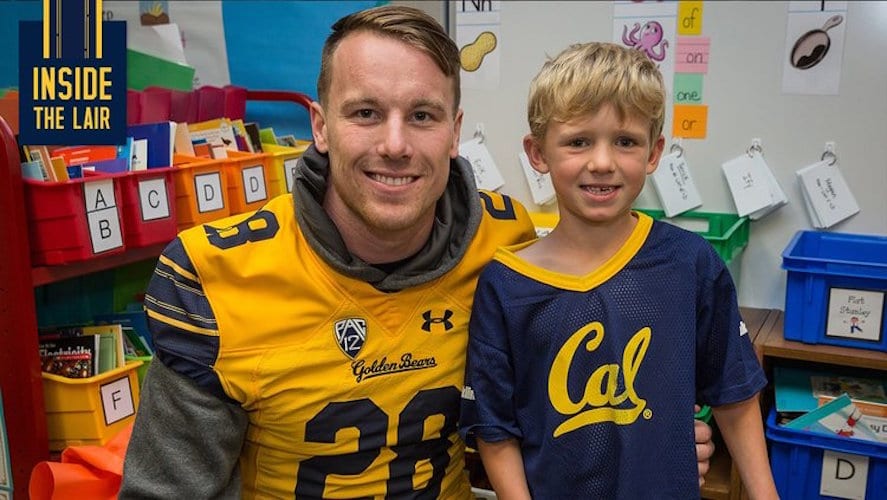
Cal Bears running back Patrick Laird, BS 18, was getting ready to play a game last year, when he felt a tap on his shoulder.
“This guy says he wants to introduce me to his son,” Laird remembers. Looking down, he saw the boy, first-grader Patrick Sproul—the great-great-grandson of former University of California president Robert Gordon Sproul—was wearing a jersey with Laird’s number, 28. “That’s when I suddenly realized I had a new platform. And I wanted to do something positive with it.”
With his newfound young fan base, Laird wanted to do more than just promote the game. He decided to create the Patrick Laird Summer Reading Challenge to encourage elementary kids in first through sixth grade to read.
Fighting “summer reading loss”
For two years on the football field, Laird had struggled to be noticed. Then, in the second game last season against Weber State, he was called in when the starting running back suffered a knee injury. Laird scored three touchdowns and rushed for 191 yards—the beginning of a breakout season for the Haas undergraduate student, who became only the 16th player in Cal history to rush more than 1,000 yards in a season.

Laird, who graduated from Haas in May but is finishing a dual political science degree this year at Berkeley, was inspired to launch his program after reading about the phenomenon of “summer reading loss,” in which kids lose their academic skills during vacation months. “They are with their teachers all year and getting better at reading and math, and then they are not reading for two and a half months,” he says. “They show up in the fall, and sometimes teachers have to spend six weeks re-teaching material that they learned last year.” The issue particularly affects low-income children, whose parents may have fewer resources to sign kids up for educational programs over the summer.
It was natural for Laird to focus his energies on reading. Growing up as the fourth of six children in Arroyo Grande, California, his parents read to him every night before bed. “I couldn’t wait until I could read chapter books like my older siblings,” he says. Racing through the “Magic Tree House” and “Hardy Boys” series, Laird was reading social science books such as “Freakonomics” by 7th grade. Those books inspired an entrepreneurial streak, propelling him to create his own businesses in video editing and car detailing in high school, and culminating in his decision to study business at Haas.
Launching a program
In fact, Laird became so known for always having his nose in a book that his teammates who lived with him in a football house two years ago joked that if he ever scored, he’d read a book for his touchdown celebration. Laid made good on that promise this season, when after scoring his first touchdown, he mocked putting his hands together and opening them in front of his face as if reading in the end zone. “I’m not ashamed to say I like to read and I love education,” he says.

When Laird conceived of the reading challenge, he consulted Haas leadership Lecturer Dan Mulhern about how to create a website. A planned 15-minute meeting lasted over an hour, as Mulhern encouraged Laird to think bigger.
“I was afraid of what people would think putting my name on this reading challenge,” Laird says. “He said, ‘Who cares about what people think, just do what you are passionate about.’ ” Ultimately, Laird created a downloadable journal where kids commit to read a certain number of books, according to their age. If they succeed, they can turn the journal in to receive four free tickets to Cal’s home opener against North Carolina on September 1.
Sending a message to students
Haas finance Lecturer Stephen Etter helped Laird work out the logistics of the launch. To promote the program, Laird toured 20 nearby elementary schools. “The kids could have spent hours asking him questions,” says Kelsey Matthiesen, a teacher at Berkeley’s School of the Madeleine. “The kids were curious about Patrick’s favorite book, animal, and color.” Laird’s example sent a positive message to the students, says Matthiesen, who estimates that well over half of them will sign up for the challenge. “They were able to relate to Patrick and look up to him because he is successful in both the classroom and on the football field.”
One student he’s already inspired is Laleaga, a rising 5th grader at Pleasant Hill’s Valhalla Elementary School who recently started reading Roald Dahl’s “Charlie and the Chocolate Factory.” “I’m very happy that Patrick came up with this idea,” she enthused. “It’s fun and a good activity to do over the summer.”
Laird stresses that even if kids didn’t download the journal at the beginning of summer, they can still catch up and get credit for the books they’ve already read. “A lot of kids say, I like to read anyways, and I think that’s awesome,” he says. “As long as they are reading more than they would have otherwise, the challenge will be a success.”